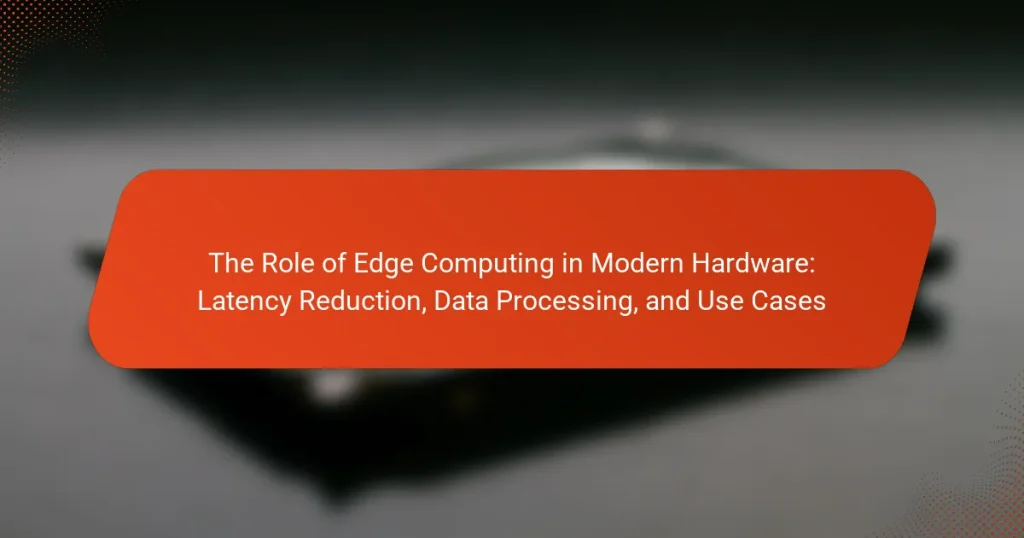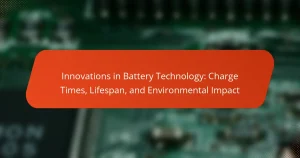Edge computing is a distributed computing paradigm that enhances performance by bringing computation and data storage closer to data sources, significantly reducing latency and bandwidth usage. This approach is vital for time-sensitive applications, particularly in modern hardware contexts such as IoT devices, autonomous vehicles, and smart cities. Key use cases include real-time data processing, efficient IoT device management, and enhanced security through local data processing. However, implementing edge computing also presents challenges, including network reliability, security vulnerabilities, operational complexity, interoperability issues, and compliance with data privacy regulations. The growing significance of edge computing is underscored by projections indicating that by 2025, a substantial majority of enterprise-generated data will be processed outside centralized data centers.
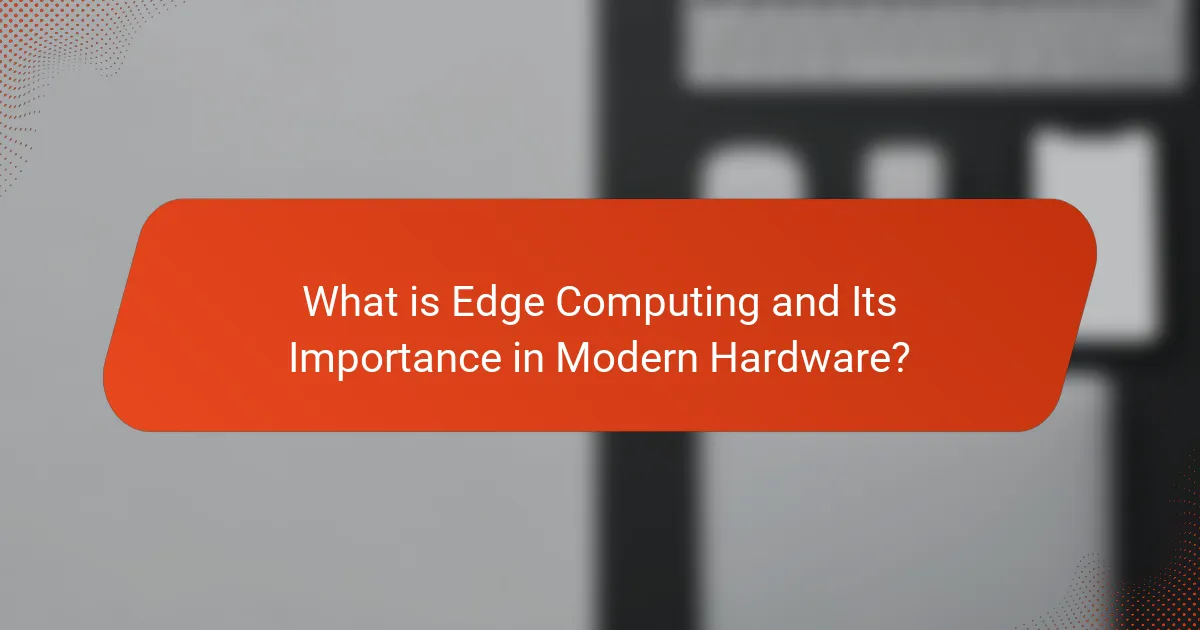
What is Edge Computing and Its Importance in Modern Hardware?
Edge computing is a distributed computing paradigm that brings computation and data storage closer to the location of the data source. This proximity reduces latency and bandwidth use, enhancing performance for time-sensitive applications. In modern hardware, edge computing plays a crucial role by enabling real-time data processing. It supports applications like IoT devices, autonomous vehicles, and smart cities, where immediate data analysis is essential. A study by Gartner indicates that by 2025, 75% of enterprise-generated data will be processed outside centralized data centers. This shift emphasizes the growing importance of edge computing in optimizing hardware efficiency and resource allocation.
How does Edge Computing differ from traditional cloud computing?
Edge computing processes data closer to the source, while traditional cloud computing relies on centralized data centers. This proximity reduces latency, leading to faster data processing and response times. In edge computing, devices such as sensors and IoT devices handle data locally. Traditional cloud computing often requires data to travel long distances to a server for processing.
According to a report by Gartner, edge computing can reduce latency by up to 75%. This is crucial for applications requiring real-time processing, such as autonomous vehicles and smart manufacturing. Additionally, edge computing can optimize bandwidth usage by minimizing the amount of data sent to the cloud.
Traditional cloud computing, however, offers greater scalability and resource management through centralized infrastructure. Each model serves different needs based on application requirements.
What are the key characteristics of Edge Computing?
Edge computing is a distributed computing paradigm that brings computation and data storage closer to the location of data generation. This reduces latency by minimizing the distance data must travel. Edge computing enhances real-time data processing, allowing for faster decision-making. It supports bandwidth efficiency by reducing the amount of data sent to centralized cloud servers. Security is also improved, as sensitive data can be processed locally rather than transmitted over networks. Scalability is a key characteristic, enabling systems to grow without significant infrastructure changes. Additionally, edge computing is energy-efficient, as it reduces the need for extensive data transmission. These characteristics make edge computing essential for applications requiring low latency and high reliability.
Why is Edge Computing becoming essential for modern applications?
Edge computing is becoming essential for modern applications due to its ability to reduce latency and improve data processing efficiency. By processing data closer to the source, edge computing minimizes the time it takes for data to travel to centralized cloud servers. This is crucial for applications requiring real-time responses, such as autonomous vehicles and industrial automation.
According to a study by Gartner, by 2025, over 75% of enterprise-generated data will be processed outside centralized data centers. This shift indicates a growing reliance on edge computing to handle vast amounts of data generated by IoT devices. Additionally, edge computing enhances bandwidth efficiency by limiting the amount of data sent to the cloud, which reduces costs and improves overall system performance.
As a result, the integration of edge computing is becoming a vital component in the architecture of modern applications.
What role does Edge Computing play in latency reduction?
Edge Computing significantly reduces latency by processing data closer to the source. This minimizes the distance data must travel to reach processing units. With traditional cloud computing, data often travels to centralized servers, leading to delays. Edge Computing places computing resources at the edge of the network, near devices generating data. This architecture allows for real-time data processing and faster response times. According to a study by Cisco, Edge Computing can reduce latency by up to 75% in certain applications. This reduction is crucial for time-sensitive tasks, such as autonomous driving and industrial automation. By enabling quicker data handling, Edge Computing enhances overall system performance and user experience.
How does proximity to data sources affect latency?
Proximity to data sources directly reduces latency. When devices are closer to data sources, the time taken for data transmission decreases. This shorter distance minimizes the number of network hops required. Fewer hops lead to faster data retrieval and processing times. Edge computing leverages this principle by placing computation closer to the data source. According to a study by Cisco, reducing the distance between data sources and processing units can lead to a latency reduction of up to 50%. Therefore, proximity significantly enhances performance and responsiveness in data-driven applications.
What technologies enable latency reduction in Edge Computing?
Technologies that enable latency reduction in Edge Computing include edge devices, content delivery networks (CDNs), and fog computing. Edge devices process data closer to the source, minimizing the distance data must travel. This proximity reduces transmission delays. CDNs cache content at various locations, speeding up access to frequently requested data. Fog computing extends cloud capabilities to the edge, allowing for real-time data processing and decision-making. Additionally, 5G networks enhance connectivity speed and reliability, further decreasing latency. These technologies collectively optimize data handling and improve response times in edge computing environments.
What are the data processing capabilities of Edge Computing?
Edge computing processes data closer to the source of generation. This reduces latency and bandwidth usage. It enables real-time data analysis and decision-making. Edge devices can handle tasks like data filtering and aggregation. They can also perform complex computations locally. This minimizes the need to send all data to centralized cloud servers. According to a study by Gartner, edge computing can reduce data transmission costs by up to 70%. Additionally, it enhances data privacy and security by keeping sensitive information local.
How does Edge Computing facilitate real-time data processing?
Edge Computing enables real-time data processing by bringing computation closer to data sources. This reduces the latency associated with data transmission to centralized cloud servers. By processing data at the edge, devices can respond more quickly to changing conditions. For example, in industrial applications, sensors can relay information and receive commands almost instantaneously. According to a study by the International Data Corporation, edge computing can reduce latency by up to 75%. This significant reduction enhances the performance of applications requiring immediate data analysis, such as autonomous vehicles and smart manufacturing systems. Thus, Edge Computing is essential for applications that demand rapid decision-making and low latency.
What are the advantages of processing data at the edge?
Processing data at the edge offers several advantages. It significantly reduces latency by processing data closer to the source. This minimizes the time taken to transmit data to centralized servers. Faster response times enhance the performance of real-time applications. Edge processing also reduces bandwidth usage. By filtering and processing data locally, only essential information is sent to the cloud. This leads to cost savings on data transmission. Additionally, edge computing enhances data privacy and security. Sensitive information can be processed locally instead of being transmitted over networks. This reduces the risk of data breaches. Overall, edge computing optimizes resource utilization and improves system efficiency.
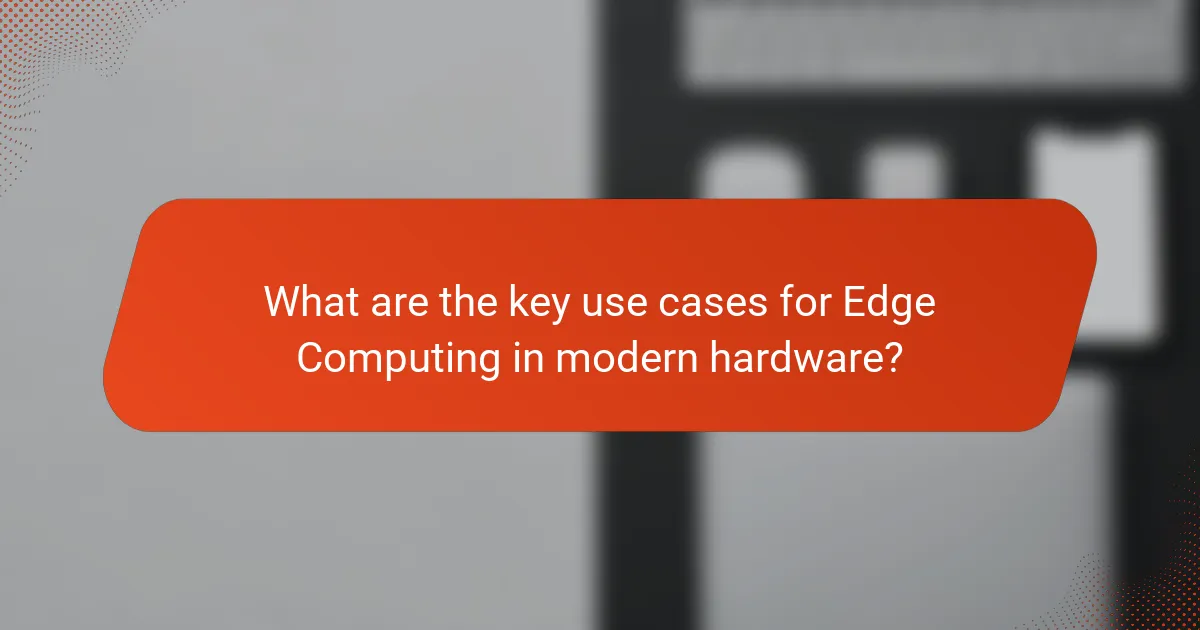
What are the key use cases for Edge Computing in modern hardware?
Key use cases for Edge Computing in modern hardware include real-time data processing, IoT device management, and enhanced security. Real-time data processing enables immediate analysis at the source, reducing latency. IoT device management allows for efficient control and monitoring of connected devices. Enhanced security measures are implemented by processing sensitive data locally, minimizing exposure to external threats. Additionally, applications in autonomous vehicles and smart cities utilize edge computing for faster decision-making. These use cases demonstrate the effectiveness of edge computing in improving performance and responsiveness in various hardware applications.
How is Edge Computing utilized in smart cities?
Edge computing is utilized in smart cities to enhance data processing and reduce latency. It allows data generated by IoT devices to be processed closer to the source. This minimizes the need for data to travel long distances to centralized servers. Real-time applications, such as traffic management and public safety systems, benefit significantly from this approach. By processing data locally, edge computing enables faster decision-making. For example, smart traffic lights can adjust in real-time based on traffic flow data. Additionally, edge computing supports efficient bandwidth usage by filtering and aggregating data before sending it to the cloud. This results in improved overall network performance and reliability in smart city applications.
What specific applications benefit from Edge Computing in urban environments?
Smart traffic management systems benefit from edge computing in urban environments. These systems analyze real-time traffic data locally to optimize traffic flow. Public safety applications also utilize edge computing. They process video feeds from surveillance cameras for immediate threat detection. Smart lighting systems leverage edge computing to adjust brightness based on pedestrian presence. Waste management systems use it for monitoring bin levels and optimizing collection routes. Environmental monitoring applications analyze air quality data locally for quick responses. Additionally, connected vehicle systems rely on edge computing for low-latency communication with infrastructure. Each of these applications enhances efficiency and responsiveness in urban settings.
How does Edge Computing enhance public safety and infrastructure management?
Edge computing enhances public safety and infrastructure management by enabling real-time data processing closer to data sources. This reduces latency in critical applications like surveillance and emergency response. For example, edge devices can analyze video feeds instantly to detect anomalies. Quick alerts can then be sent to authorities, improving response times. Additionally, edge computing supports smart infrastructure, allowing for proactive maintenance of public assets. It can predict failures in transportation systems through real-time monitoring. Studies show that these technologies can reduce response times by up to 50%. Overall, edge computing significantly improves operational efficiency and safety in urban environments.
What role does Edge Computing play in the Internet of Things (IoT)?
Edge computing enhances the Internet of Things (IoT) by processing data closer to the source. This reduces latency, allowing for real-time data analysis and quicker response times. By decentralizing data processing, edge computing alleviates bandwidth strain on cloud services. It enables devices to operate autonomously, improving efficiency and reliability. According to a report by Gartner, by 2025, 75% of enterprise-generated data will be created and processed outside centralized data centers. This shift supports the scalability of IoT applications, making them more effective in various use cases, such as smart cities and industrial automation.
How does Edge Computing improve IoT device performance?
Edge computing enhances IoT device performance by processing data closer to the source. This reduces latency significantly, enabling faster response times. For example, edge computing can cut down data transmission times to milliseconds. By minimizing the distance data must travel, it alleviates bandwidth congestion. Additionally, it allows for real-time analytics and decision-making at the device level. This capability is crucial for applications like autonomous vehicles or smart manufacturing. Research shows that edge computing can improve processing speeds by up to 50% compared to traditional cloud computing. Overall, edge computing optimizes the efficiency and responsiveness of IoT devices.
What are the security implications of using Edge Computing in IoT?
Edge computing in IoT introduces several security implications. First, data processing occurs closer to the source, which can reduce latency but may expose sensitive data at the edge. This decentralization increases the attack surface, making devices vulnerable to unauthorized access and attacks.
Additionally, edge devices often have limited computational resources and may lack robust security measures. This can lead to inadequate protection against malware and hacking attempts. According to a report by the Ponemon Institute, 60% of organizations experienced an IoT-related breach in the last year, highlighting the risks involved.
Furthermore, data transmitted between edge devices and central servers can be intercepted if not properly encrypted. This raises concerns about data integrity and confidentiality. Security protocols must be implemented to safeguard data in transit and at rest.
Overall, while edge computing enhances performance, it necessitates a stronger focus on security measures to mitigate potential vulnerabilities.
What industries are transforming with Edge Computing technology?
Manufacturing, healthcare, retail, transportation, and telecommunications are industries transforming with Edge Computing technology. In manufacturing, Edge Computing enables real-time data processing for predictive maintenance. Healthcare benefits from improved patient monitoring and data analysis at the source. Retail uses Edge Computing for enhanced customer experiences through personalized services. Transportation relies on Edge Computing for real-time traffic management and vehicle connectivity. Telecommunications enhances network performance and reduces latency with Edge solutions. These transformations lead to increased efficiency and better decision-making across these sectors.
How is Edge Computing impacting healthcare delivery?
Edge computing is significantly impacting healthcare delivery by enabling real-time data processing at the source of data generation. This reduces latency, allowing for quicker decision-making in critical situations. For instance, edge devices can analyze patient data on-site, leading to immediate insights during emergencies.
In addition, edge computing supports remote monitoring of patients, ensuring continuous health tracking outside traditional clinical settings. According to a study by the Journal of Medical Internet Research, 70% of healthcare providers reported improved patient outcomes due to faster data access.
Furthermore, it enhances data security by processing sensitive information locally, minimizing the risk of data breaches during transmission. This capability is crucial in healthcare, where patient confidentiality is paramount. Overall, edge computing transforms healthcare delivery through efficiency, security, and improved patient care.
What are the benefits of Edge Computing in manufacturing processes?
Edge computing enhances manufacturing processes by reducing latency, improving data processing, and enabling real-time analytics. This technology allows data to be processed closer to the source, minimizing delays in decision-making. For instance, a study by Deloitte found that edge computing can reduce latency by up to 50%. It also increases operational efficiency by enabling predictive maintenance. This reduces downtime and extends equipment lifespan, as data is analyzed in real time to identify potential issues. Furthermore, edge computing supports enhanced automation by facilitating faster responses to changing conditions on the factory floor. Overall, these benefits lead to significant cost savings and improved productivity in manufacturing operations.
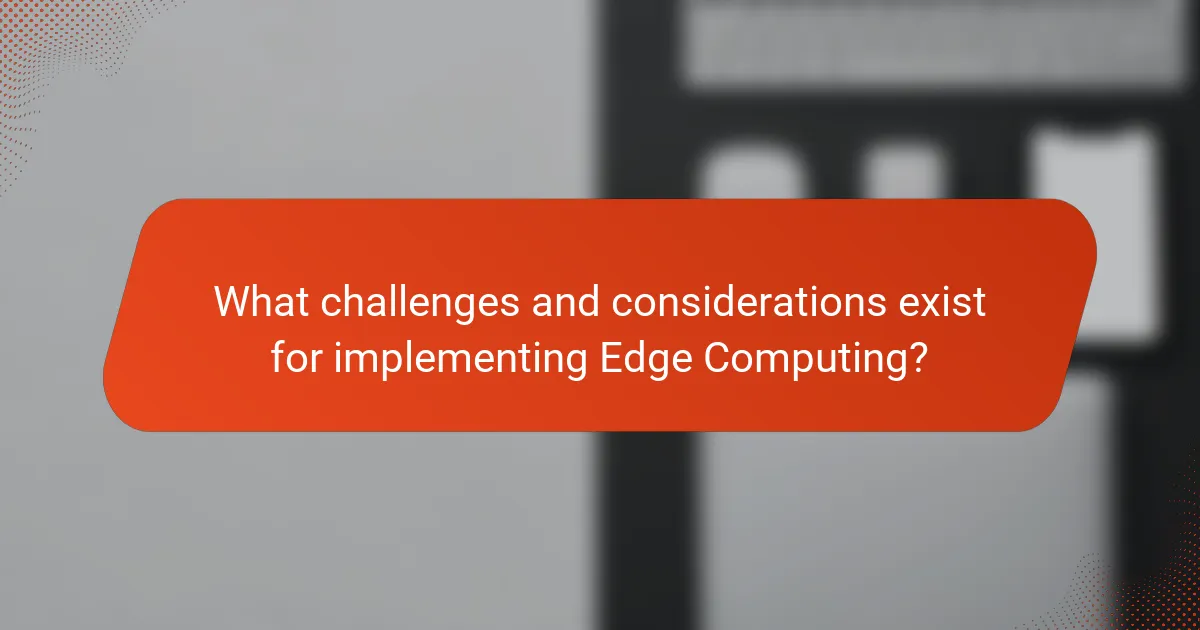
What challenges and considerations exist for implementing Edge Computing?
Implementing Edge Computing presents several challenges and considerations. Firstly, network reliability is crucial as edge devices rely on stable connections. Unreliable networks can lead to data loss or processing delays. Secondly, security concerns arise due to the distributed nature of edge computing. Devices at the edge are often more vulnerable to attacks. Thirdly, managing and maintaining numerous edge devices can be complex. This complexity increases operational costs and requires skilled personnel. Additionally, ensuring interoperability among different systems and devices poses a significant challenge. Lastly, data privacy regulations must be adhered to, especially when handling sensitive information at the edge.
What are the common obstacles faced when adopting Edge Computing?
Common obstacles faced when adopting Edge Computing include high implementation costs, complexity in integration, and data security concerns. High costs arise from the need for specialized hardware and software. Complexity in integration stems from the need to connect multiple devices and systems. Data security concerns are heightened due to the distributed nature of edge devices. Additionally, limited interoperability between different vendors can hinder deployment. Skills shortages in edge computing expertise also pose challenges. Finally, regulatory compliance can complicate the adoption process, especially in sensitive industries.
How can organizations overcome these challenges?
Organizations can overcome challenges related to edge computing by implementing robust infrastructure. They should invest in high-performance hardware to support data processing needs. Training staff on edge computing technologies is essential for effective deployment. Establishing clear data governance policies will enhance data security and compliance. Collaborating with technology partners can provide necessary expertise and resources. Regularly updating software and hardware ensures optimal performance. Investing in network reliability minimizes latency issues. Finally, adopting a phased implementation strategy allows organizations to address challenges incrementally.
What best practices should be followed for successful Edge Computing deployment?
Successful Edge Computing deployment requires a strategic approach. First, assess the specific use case and requirements. Identify the data processing needs and latency requirements. Next, ensure robust security measures are in place. Implement encryption and secure access controls. Additionally, choose the right hardware and software platforms. Compatibility with existing systems is crucial. Regularly monitor and manage the edge devices. This ensures optimal performance and quick issue resolution. Finally, plan for scalability. As demand grows, the system should be able to expand without significant reconfiguration. These practices lead to efficient and effective Edge Computing implementations.
What future trends can be expected in Edge Computing and hardware integration?
Future trends in Edge Computing and hardware integration include increased adoption of AI and machine learning capabilities. These technologies enhance data processing at the edge, enabling real-time analytics. There is also a shift towards more decentralized architectures. This approach reduces latency and improves responsiveness. Additionally, the integration of 5G technology will facilitate faster data transmission. This will further support the growth of IoT devices at the edge. Security measures will evolve to address vulnerabilities in distributed systems. Finally, energy-efficient hardware solutions will emerge to optimize power consumption in edge deployments.
How will advancements in technology shape the future of Edge Computing?
Advancements in technology will significantly enhance the capabilities of Edge Computing. Innovations in artificial intelligence (AI) will enable smarter data processing at the edge. This will lead to reduced latency in real-time applications. Improved hardware, such as faster processors and more efficient memory, will increase processing power at edge devices. Enhanced connectivity, including 5G networks, will facilitate quicker data transfer between edge devices and central servers. The integration of Internet of Things (IoT) devices will expand the data sources that Edge Computing can handle. As a result, industries will benefit from more responsive and efficient operations. These advancements will drive the adoption of Edge Computing across various sectors, including healthcare, manufacturing, and smart cities.
What innovations are on the horizon for Edge Computing applications?
Innovations on the horizon for Edge Computing applications include enhanced AI integration, improved data analytics, and advanced cybersecurity measures. AI integration allows for real-time decision-making at the edge. This reduces latency and improves efficiency in various applications. Improved data analytics enables more effective processing of large datasets locally. This minimizes the need for data to travel to centralized data centers. Advanced cybersecurity measures are being developed to protect edge devices from increasing threats. These innovations are driven by the growing demand for faster, more secure, and efficient computing solutions. According to a report by Gartner, the edge computing market is expected to grow significantly, highlighting the importance of these innovations.
What practical tips can organizations follow to leverage Edge Computing effectively?
Organizations can leverage Edge Computing effectively by implementing several practical strategies. First, they should identify specific use cases that benefit from reduced latency. These can include real-time data processing for IoT devices or applications requiring instant feedback.
Next, organizations must invest in appropriate hardware and software solutions tailored for edge environments. This includes edge servers and optimized applications to handle local data processing.
Additionally, companies should ensure robust security measures are in place. Edge devices often handle sensitive data, making cybersecurity a priority.
Regular monitoring and maintenance of edge infrastructure are essential. This ensures optimal performance and quick troubleshooting of issues as they arise.
Finally, organizations should foster collaboration between IT and operational technology teams. This enhances the integration of Edge Computing into existing workflows and maximizes its benefits.
These strategies are supported by industry reports indicating that effective Edge Computing implementations can significantly enhance operational efficiency and data processing capabilities.
Edge computing is a distributed computing paradigm that enhances modern hardware by reducing latency and improving data processing efficiency. This article explores the significance of edge computing in various applications, including IoT devices, autonomous vehicles, and smart cities, highlighting its role in real-time data analysis. Key characteristics such as bandwidth efficiency, enhanced security, and scalability are discussed, along with the challenges of implementation. Additionally, the article examines specific use cases in industries like healthcare and manufacturing, emphasizing the transformative impact of edge computing on operational performance and decision-making.
